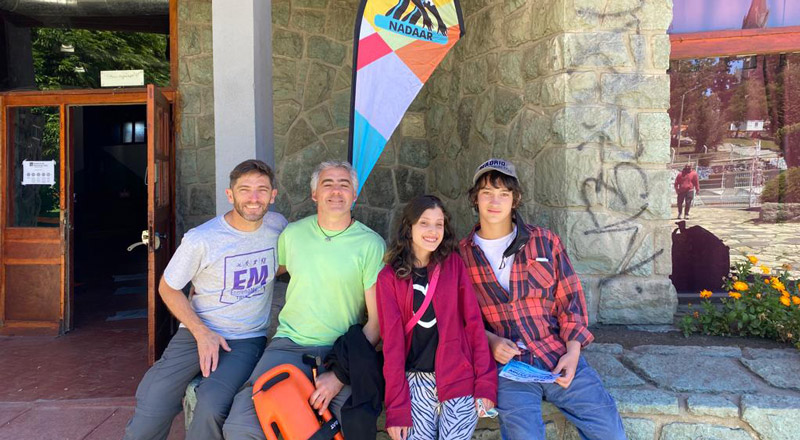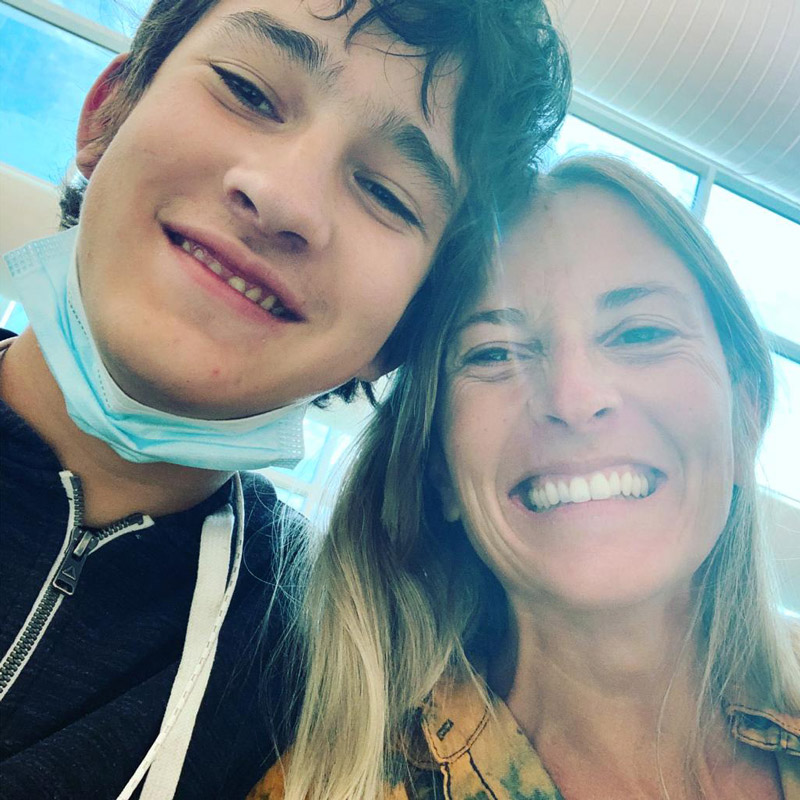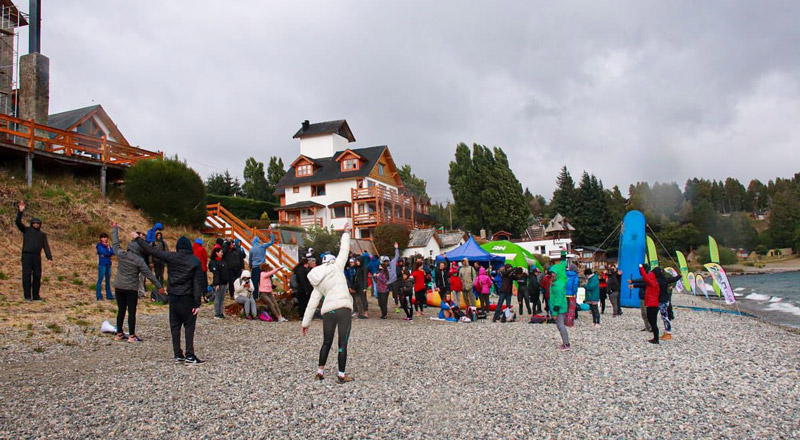
Nicolás came to the swimming practices of Club Pehuenes de Bariloche more than fifteen years ago — at age 14 — because he had difficulty doing other sports. When Ignacio Acuña received him, he remembered his teacher Hector Pocho Ramirez, who used to say: “You have to look into your eyes.” So, he faced the challenge with his first student with disabilities and the initial contact was visual... And in the water.
Twenty years ago, adapted swimming was not rooted in society. While Acuña's vocational training at the Romero Brest Institute of Physical Education was with guidance in Special Education, he says that the first student “fell from the sky”. Nicolás arrived on the recommendation of an occupational therapist friend who had suggested that he work on psychomotor skills. And water was the means to do it.
Swimming is ideal for people with disabilities, as it is a sport in which the motor and psychomotor system are involved. “I had never worked alone, I had always attended other teachers. Not many kids with disabilities went to the club either. Nicolás was one of the few,” Acuña recalls. In water, the body weighs less, becomes more flexible and all the limbs are put into operation.
“We quickly realized how good swimming was doing for him and little by little other children joined,” says Acuña and recalls his training period with Pocho Ramírez, a precursor who worked at the National Institute of Rehabilitation directing physical activities for people with sequelae of poliomyelitis and motor disability and founded the Argentine Federation of Wheelchair Sports (FADESIR), which combines various disciplines such as basketball, fencing, swimming, athletics, weights and shooting. In 2011 he was declared Outstanding Personality of Education and Sports in the Buenos Aires Legislature.

“The start was very good and of great help to take care of the general physical condition. It helped Nicolás a lot to maintain muscle strength and, in addition, to relax the body after his daily activities,” says his mother Maria Lidia de la Fuente. “Any activity that adapts to diverse realities and capacities is positive to generate progress in the inclusion of people in society,” he adds.
“At first I had a hard time teaching the classes, but until I realized that I could have fun, to have fun when the boys were with me. Making them laugh, having fun and doing exercises was the premise,” says the professor of Club Pehuenes.
Swimming helps people with disabilities grow and develop physically, socially and emotionally. Playing sports generates emotional and cognitive experiences, promotes the development of coordination, agility and balance, as well as educating the body scheme and body control in the aquatic space.
“Working with them is learning to be flexible. You have to plan, but if they are not willing to make it happen, you need to change plans and you have to adapt quickly. It is very satisfying what we do, and I say 'we' do 'because they change the way we see things. I learn with them and try to give them the best for each one,” Acuña describes.
Physical work and enjoyment
Candela arrived at Club Pehuenes without knowing how to swim. It currently floats and swims short sections. Her father, Francisco Hernández, highlights how sport helps her in her daily life: “Candela likes to socialize with other swimmers, no matter how old they are. He likes to say hello to the lifeguards. I would tell any parent that their son or daughter does not miss this enriching activity.”
Meanwhile, Lulu Mathis, mother of Tomás Lezcano, Ignacio Acuña's second student, who arrived at the age of just two and has been swimming for 14 years, reviews: “Tomás has a rare disease called GLUT-1 deficiency. He started taking classes because it seemed to us that water could be a friendly environment so that he could advance his mobility. When he first went to the pool, he didn't walk.”
In addition to mobility aid, her parents believed that sport was also an ideal space to strengthen their self-confidence and safety. “Dad and I really like sports and we live in a city like Bariloche, where there is water everywhere,” Mathis says. Indeed, the Patagonian city is surrounded by the Steffen, Nahuel Huapi, Moreno, Mascardi, Escondido, Guillelmo and Gutiérrez lakes, among others. “We wanted him to have the swimming tool, it seemed very important to us. We didn't know how much he was going to be able to achieve, but we were sure of the enjoyment that he would have from being in contact with water,” he adds.

Acuña reviews the progress made with Tomás, since one of the symptoms of GLUT-1 is ataxia, a motor disorder characterized by a lack of coordination in carrying out voluntary movements. “Many said that it was impossible for Tomás to swim, because of his sporadic movements, but it was possible to show that a lot of things can be corrected and modified through sports and swimming,” the professor emphasizes, adding that the story was presented at a health congress in California where they showed videos about how their swimming lessons were developed.
“First he learned to float, then to kick, then to move his arms, and, finally, he joined all the parts,” recalls Tomás's mother. “The progress is very exciting. In these 16 years we see this day by day. Because when you have a child with a disability, if there's one thing you learn, it's how to be patient. The times of the other are not the times of one. It doesn't matter how long an apprenticeship takes, because, in the end, it succeeds. With great tenacity, enjoying what he does. That's what Tomy has given us all this way,” he adds.
Beyond water
Alejandra is the mother of Gonzalo García Platini, who when she was finishing seventh grade an integrating teacher suggested that she swim. “Gonza is 15 years old, she has a generalized maturative decline that affects her cognitive aspects such as her motor skills and also has an impact on the social aspect. The changes that Gonza has had are insurmountable and the progress even more so. The impact is physical, emotional and social”, he emphasizes.
Physically, Gonzalo improved his posture and his way of walking. “And he developed the orientation, because they also go to the mountains and go hiking, that makes him know much more about the geography in which he lives. In the social sphere, it has made great strides in this time. It is clear that when a child is inserted into a sports environment, it is not the same experience as in school. There is fun there, there is play, there is a different way to connect with other children. And the teacher's way of promoting integration is fundamental, he does it from play and sport”, points out Alejandra.

Acuña's classes transcend the pool. The teacher also plans activities outside the water. “I take some of them to walk in the mountains, to others I propose manual tasks or ride a bicycle. My goal is to make them discover their passion for something,” says Nacho, who says that Gonzalo didn't like hiking very much at first and now asks him to visit a new mountain every time they embark on a tour of Bariloche's trails.
Sport as a social engine
“Just joining a club is important, that means socializing,” says Lulu, Tomás's mother. “Because the focus is on the person and not on the disability. The capacities are then equated with those of the other people who are enjoying the pool. It's a look of real inclusion,” he adds.
According to Acuña, some institutions accept children with disabilities “for regulatory compliance, but not everywhere there are adapted bathrooms or ramps.” “This should change. Otherwise, inclusion is not such,” he adds.

Lulu highlights the role of the community. “We must encourage ourselves to be part of a society, to continue building an inclusive community. Living with disability day by day is not easy, because sometimes we feel alone, but it is up to us to include our children in society. And we have to add up for them to be included. The theme is to build from capacities. Sport includes, provides values and generates community,” he adds.
Acuña has been working for twenty years focusing on inclusion. His swimming lessons are not specific to children with disabilities, but rather points to integration: “I give some kids private lessons until they get ready to share with the rest of the Pehuenes Club swimming school. It is very important for them that these stories are told. It vitalizes them, gives them energy and desire to move forward. Sharing this experience in the media can change their lives. The sharing of history is a rebirth.”
____________
This note is part of the Solutions for Latin America platform, an alliance between INFOBAE and RED/ACTION.
Últimas Noticias
Debanhi Escobar: they secured the motel where she was found lifeless in a cistern
Members of the Specialized Prosecutor's Office in Nuevo León secured the Nueva Castilla Motel as part of the investigations into the case

The oldest person in the world died at the age of 119
Kane Tanaka lived in Japan. She was born six months earlier than George Orwell, the same year that the Wright brothers first flew, and Marie Curie became the first woman to win a Nobel Prize

Macabre find in CDMX: they left a body bagged and tied in a taxi
The body was left in the back seats of the car. It was covered with black bags and tied with industrial tape
The eagles of America will face Manchester City in a duel of legends. Here are the details
The top Mexican football champion will play a match with Pep Guardiola's squad in the Lone Star Cup

Why is it good to bring dogs out to know the world when they are puppies
A so-called protection against the spread of diseases threatens the integral development of dogs




